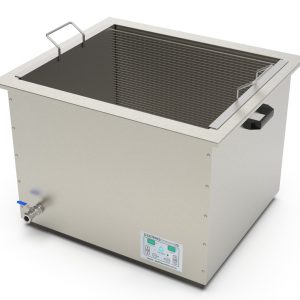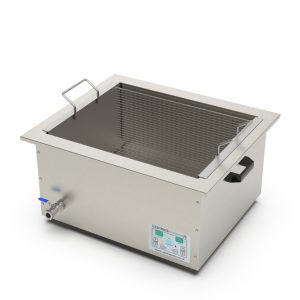Ultrasonic Cleaning Machines For Car Parts
Manually cleaning car parts is time-consuming and usually, the parts are not cleaned completely, which can affect the car’s performance. However, investing in an ultrasonic parts cleaner eliminates this problem as the cleaning system can penetrate the smallest cavities with its ultrasonic waves.
The ultrasonic parts cleaner is set to a specific frequency to release sound waves causing cavitation bubbles that can get into the tightest areas of the car part. The cavitation bubbles implode, generating localised high temperature and pressure that produces continuous tiny shock waves, capable of dislodging the toughest of contaminants. At EJ Ultrasonics, our cleaning systems are highly effective and eco-friendly, resulting in a pristine car part and a greener planet.

What Type Of Ultrasonic Cleaner To Use For Cleaning Car Parts?
When choosing the right ultrasonic cleaner tank for any regular task, there are certain factors that come into play, but even more so when the task is cleaning car parts. As the environment car parts exist in is liable to become clogged with dirt, grease and debris, the importance of thorough cleaning is paramount for high performance and complete safety. Below are the three most important factors you must consider:
Tank Size
It goes without saying many car parts can be quite sizeable and heavy, so you’ll want an ultrasonic cleaning tank that can accommodate the various parts without compromising on its cleaning capabilities.
Frequency And Power
For heavy and durable car parts, a lower-frequency ultrasonic cleaning machine with a higher power is typically better for effective and thorough cleaning. Between 25-40 kHz would be considered the ideal frequency.
Equipment Material
You should only be considering stainless steel ultrasonic cleaning tanks as they are corrosion resistant and able to withstand any solvents typically used in car part cleaning.
We recommend the AT120i. An industrial ultrasonic parts cleaner with a tank capacity of 120 litres, a frequency of 33 kHz and a body made entirely of stainless steel. The AT120i comes with precision temperature settings, from 0° to 80°, ensuring optimal cleaning conditions for all your car parts.
Benefits Of Ultrasonic Cleaning For Car Parts
Ultrasonic cleaning of car parts offers several advantages over traditional cleaning methods, making it a popular choice for both professional and amateur mechanics. Here are some key benefits:
Precision Cleaning
The cavitation bubbles in ultrasonic cleaning tanks can reach the most inaccessible areas of complex objects without disassembly.
Saves Time
Manually, you could spend 10 minutes scrubbing a single bolt or washer, but the ultrasonic tank can clean multiple parts simultaneously in half the time.
Labour Costs
The time saved by employing the industrial ultrasonic parts cleaner can be used in other areas of your project, increasing productivity without increasing costs.
Eco-Friendly
As ultrasonic cleaning of car parts doesn’t rely on harsh chemicals, and typically uses milder detergents, it is more environmentally friendly.
Consistent Results
The automated nature of ultrasonic cleaning ensures more consistent results, which is crucial in maintaining high levels of quality control demanded by consumers.
Non-Abrasive
An industrial ultrasonic part cleaner is less abrasive than traditional methods and so is less likely to damage any sensitive or fragile parts.
Versatile
Ultrasonic cleaning can remove a wide range of contaminants including grease, oil, dirt, carbon deposits, soot and more, and is suitable for use with various materials such as metals, plastics and ceramics.
Safety
With no requirement for harsh chemicals or manual scrubbing, ultrasonic cleaning can be gentler and minimise exposure to chemicals.
Car Parts That Can Be Cleaned Using Ultrasonic Cleaners
As long as the car part is made of a compatible material, an industrial ultrasonic parts cleaner is the perfect choice. Here are some parts it is ideal for:
- Carburettors
- Fuel Injectors
- Bearings
- Brake Callipers and Pads
- Transmission Valves
- Gears
- Airflow Sensors
It can also be used to clean switches, valve lifters, oil cooler lines, EGR valves, piston rings, alternator components and many more. For further information click here.
How It Works
Choose Your Cleaning Solution
There are a lot of fantastic detergents and cleaning solutions on the market that are all more than capable of doing a thorough job of cleaning your car parts, but it is always advisable to research a solution that is designed specifically for the material being cleaned and the contaminants being removed.
Set-Up The Ultrasonic Cleaner
The first step is to fill the tank with cold water. It is important the water is cold as it will heat up during the process, and if it gets too hot the water will need to be replaced.
Add The Cleaning Solution
You then need to add your cleaning solution of choice to the cold water in the ultrasonic cleaning tank, place your parts to be cleaned in the basket, if your machine comes with one, or direct into the water/solution mix and secure the lid.
Ultrasonic Cleaning Cycle
Turn your ultrasonic cleaning machine on and set the heat to your desired temperature on the main control panels. Set your timer and press start. If your unit comes with a degas button, press this prior to starting as it is a feature designed to remove trapped air and gas bubbles from the cleaning solution that may interfere with the process.
Scientific Process
The ultrasonic cleaning system sends electrical energy to the transducer, where it is converted into high-frequency sound waves which are emitted into the cleaning solution. The sound waves produce cavitation bubbles that generate continuous tiny shock waves, dislodging contaminants from the car part’s surface.
Rinsing And Drying
Once the allocated time has been completed, turn off the unit and remove your car parts. Rinse them under cold water to remove any loose debris and dry them using blue roll or set them to the side.
Ultrasonic Cleaning Best Practice
For quality cleaning, it is important to follow best practices and the main points to consider are:
Preparation
Ensure you have your unit set up correctly for the task it is to undertake, including only filling the tank with cold water and a suitable cleaning solution. Choose the optimum temperature and cleaning cycle and don’t interfere with the machine’s process.
Compatibility
An ultrasonic cleaning tank is filled with a liquid, so there are many materials unsuitable for this cleaning process including, electrics such as circuit boards and microchips, fabrics and absorbent materials, porous or fragile materials and items with adhesive joints. It is always important to check the manufacturer’s guidelines to ensure your item is compatible.
Don’t Overcrowd The Tank
Much like when you cook food in an oven, if you overcrowd the basket in an ultrasonic cleaning tank, your parts will prevent the waves from accessing each other. This can result in uneven cleaning, shadowing effects, collisions, cross-contamination and add strain to the system.
Regular Maintenance And Servicing
The maintenance and servicing of your machine will vary depending on personal usage, so it is important to follow the manufacturer’s upkeep instructions and address any repairs.
Safety First – Take Precautions
As with any electrical machine, there are many safety guidelines to ensure the risk of damage to operators or machinery is minimised and supplied in the manual. Please read fully before commencing operation.
Recommended Products
At EJ Ultrasonics, we have nearly 30 years of experience in the ultrasonic cleaning industry, and we are always happy to share our knowledge with our customers so check out these great units. Get in touch today for all of your ultrasonic cleaner needs.
AT28i Industrial Ultrasonic Cleaning Unit
One of our smallest available units which comes at a fantastic price that reflects this. It is ideal for the cleaning of groups of smaller items on a regular basis, such as nuts, bolts and washers. It has a capacity of 28 litres, weighs 30kg and has internal dimensions of 600 x 500 x 250mm.
It has an operating voltage of 220/240V and an ultrasonic power of an impressive 800W. Operating at 33kHz you can adjust the time anywhere from one minute to one hour and the temperature goes up to 80° Celsius.
AT200i Industrial Ultrasonic Cleaning Unit
At the other end of the size scale is the durable and robust AT200i which offers a huge ultrasonic cleaning tank with a capacity of 200 litres. There are not many car parts you cannot fit in it. The full internal dimensions are 700 x 600 x 500mm and it weighs a mere 35kg. The AT200i also operates at a voltage of 220/240V but offers a considerable ultrasonic power of 1KW/2KW. Like all products within our range, it can be set for any time up to one hour and can reach temperatures of 80° Celsius.



